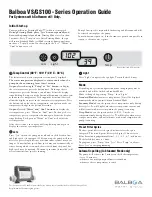
s
tart
-u
P
Note:
The settings of the hardware configuration jumpers are read when the controller is powered. Any changes to the jumper settings
require cycling power to the controller or sending a controller a reboot command through the network communications.
Table 11: I/O expansion module jumper settings
I/O Expansion Description
Jumper(s)
Jumper Setting
Model
Not Used
JP1
JP1
Open
–
Not Used
JP2
JP2
Open
–
Secondary Heating
Options
JP3 & JP4
JP3
Open
None
JP4
Open
JP3
Shorted
Supplemental Electric Heat
JP4
Open
JP3
Open
Boilerless Electric Heat
JP4
Shorted
Cooling / Dehumidification
Options
JP5 & JP6
JP5
Shorted
Without Hydronic Cooling
JP6
Open
JP5
Open
Hydronic Cooling (Waterside Economizer)
JP6
Shorted
Not Used
JP7
JP7
Open
–
Lead Compressor Option
JP8
JP8
Open
Compressor #1 is Lead (factory default setting)
JP8
Shorted
Compressor #2 is Lead
IM 1059-12 LARGE VERTICAL WSHP
25 www.DaikinApplied.com
Figure 17: I/O expansion module configuration jumper
terminals
Jumper Terminals
3 .
Set thermostat to “Cool”. If the thermostat is an
automatic changeover type, simply set the cooling
temperature to the coolest position. On manual
changeover types additionally, select “Cool” at the
system switch.
Again, many conditioners have time delays which
protect the compressor(s) against short cycling.
After a few minutes of operation, check the
discharge grilles for cool air delivery. Measure
the temperature difference between entering and
leaving water. It should be approximately 1½
times greater than the heating mode temperature
difference. For example, if the cooling temperature
difference is 15°F (8°C), the heating temperature
difference should have been 10°F (5°C).
Without automatic flow control valves, target a
cooling temperature difference of 10°F to 14°F (5°C
to 8°C). Adjust the combination shutoff/balancing
valve in the return line to a water flow rate which will
result in the 10˚F to 14°F (5°C to 8°C) difference.
4 .
Set thermostat to “Heat.” If the thermostat is the
automatic changeover type, set system switch to the
“Auto” position and depress the heat setting to the
warmest selection. Some conditioners have built-in time
delays which prevent the compressor from immediately
starting. With most control schemes, the fan will
start immediately. After a few minutes of compressor
operation, check for warm air delivery at discharge
grille. If this is a “cold building” start-up, leave unit
running until return air to the unit is at least 65°F (18°C).
Measure the temperature difference between
entering and leaving air and entering and leaving
water. With entering water of 60°F to 80°F (16°C to
27°C), leaving water should be 6°F to 12°F (3.3°C
to 6.6°C) cooler (under full load conditions) and the
air temperature rise through the machine should not
exceed 35°F (19°C). If the air temperature exceeds
35°F (19°C), then the water flow rate is inadequate.
5 .
Check the elevation and cleanliness of the
condensate line. If the air is too dry for sufficient
dehumidification, slowly pour enough water into the
condensate pan to ensure proper drainage.
6 .
If the conditioner does not operate, check the
following points:
a. Is supply voltage to the machine compatible?
b. Is thermostat type appropriate?
c. Is thermostat wiring correct?
















































